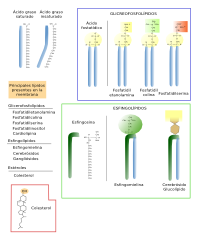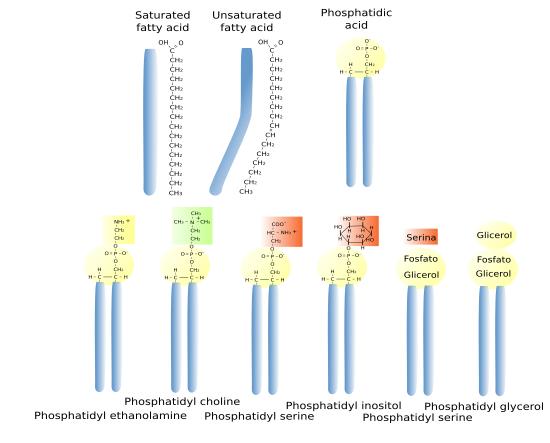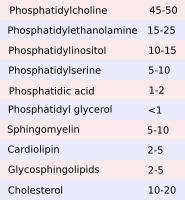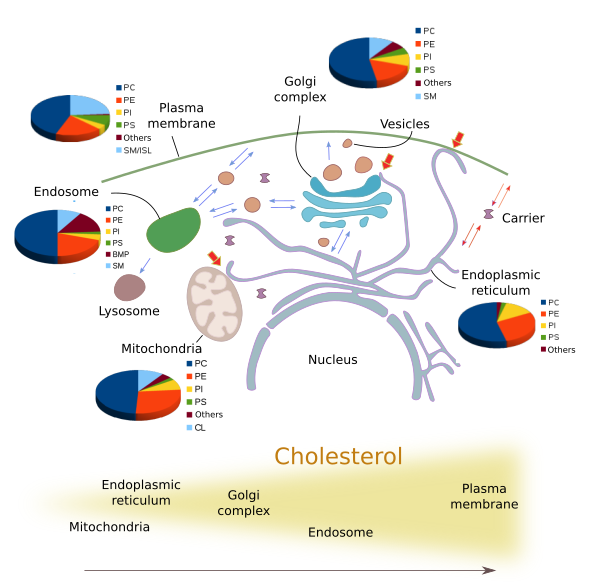What Are The Differences In The Way Lipids Are Found Or Function In Plants And Animals?
This page contents
1. Phosphoglycerides
2. Sphingolipids
3. Sterols
4. Distribution
five. Asymmetry
The structural system and properties of prison cell membranes are determined past their molecular components (lipids, proteins and carbohydrates). Lipids are essential for membranes considering they spatially organize in lipid bi-layers, i.e., cellular membranes, and can attune membrane properties since in that location are more than 1000 different lipid species in eukaryote membranes. Lipids are in charge of concrete features of membranes. Length and saturation of their fat acrid bondage regulate fluidity and thickness of membranes. The uneven distribution between the ii lipid mono-layers generates membrane asymmetry. Electrical charges located in the hydrophilic lipid heads influence the electric slope that membranes have between the external and internal membrane surfaces, modulating the membrane potential. Through lateral interactions, lipids tin modulate the activity of the membrane proteins. Furthermore, lipids may work as second messengers, leaving membranes and diffusing to intracellular compartments to trigger cellular responses. The lateral heterogeneity of cell membranes are idea to be caused by lateral lipid-lipid interactions, forming pocket-sized and plastic domains of college densely packed lipids that comprise higher proportions of certain type of lipids and proteins. These regions are known every bit lipid rafts or membrane domains.
Lipids brand upwardly around 50 % of the plasma membrane weight, with virtually five meg lipids per µmii of membrane. There are more than thousand types of lipids distributed through the different membranes of an eukaryotic cell, with specific proportions depending on the membrane. About 5 % of the genes of a prison cell are related to lipid synthesis.

Membrane lipids testify a hydrophobic domain toward the inner office of the membrane and a hydrophilic domain toward the aqueous environment. That is why they are known as amphiphilic. At that place are three mayor groups of membrane lipids regarding their structure and molecular composition: glycerophospholipids (also known as glycerolipids, phosphoglycerides or simply phospholipids), sphingolipids and sterols (Figure 1).
i. Glycerophospholipids or phosphoglycerides
G lycerophospholipids are the most abundant type of lipids in cell membranes, more than seventy % of membrane lipids. Structurally, they have 3 domains: two fat acrid bondage, glycerol, and phosphoric acid (Figure 2). Other molecules bind to the phosphoric acid providing molecular diversity. Fatty acid bondage are 13 to 19 carbon atoms in length. Well-nigh of the carbon-carbon bonds are simple, which are referred to every bit saturated bonds. More than one-half of the fat acids contain at least ane double carbon-carbon bond, which is referred to every bit unsaturated. Each double bail makes a permanent bend in the fatty acid chain and, although rotation of these bondage is restricted, the increase of unsaturated fat acids makes membranes more than fluid because the lipids are more than separated between each other. Fat acids plant the inner hydrophobic (water phobia or water flee) part of membranes.

Chiliadlycerol links the two fat acid bondage to a phosphoric acrid of the polar function or caput. In the head, the phosphoric acid is also linked to a wide variety of molecules like ethanolamine, choline, serine, glycerol, inositol, or inositol four,5-bi-phosphate, that produces the unlike species of glycerophospholipids. The names of the different glycerophospholipids derive from these molecules. For example, phosphatidylcholine accounts for more than 50 % of the lipids of the eukaryote membranes.
ii. Sphingolipids
Southward phingolipids incorporate a molecule of sphingosine, which is a nitrogenated alcohol with a large carbon chain bond to a fatty acrid chain. These ii form a molecule known as ceramide (Figure 3. Run into as well effigy 1). Diverse polar heads can be linked to ceramide. In this way, sphingolipids show a molecular structure similar to glycerophospholipids: ii hydrophobic chains linked to one hydrophilic head. Almost of membrane glycolipids, which are those containing sugar in the hydrophilic domain, are sphingolipids. Glycolipids tin can be found by and large in animal cell membranes. Sphingomyelin, other type of sphingolipid, contains ane ethanolamine or one phosphorylated choline in the hydrophilic head. Sphingolipids are more abundant in the plasma membrane than in organelles, and are proposed, together with cholesterol, as main players in the lateral segregation of membrane molecules into domains such equally lipid rafts.

3. Sterols

C holesterol (Effigy 4) is the near of import sterol in fauna cell membranes and the third most abundant blazon of lipid in plasma membrane (up to 25 % of the full lipids) of fauna cells, whereas it is deficient in membranes of organelles similar endoplasmic reticulum (about 1 % of the total lipids), mitochondria and chloroplasts. Cholesterol is located among the fatty acid bondage of other lipids. Cholesterol is non present in establish cell membranes, in some unicellular eukaryotes, nor in bacteria. However, these cells acquit other types of sterols in their membranes. Sterols are essential for the integrity and functions of eukaryotic plasma membranes. Cholesterol influences fluidity, stiffness and permeability of membranes. Moreover, it may modulate the activeness of GPCR (G protein-coupled receptors), indicate transduction and vesicular traffic. It is important for the system of membranes, particularly the plasma membrane, because, together with sphingolipids, contributes to create lateral membrane domains. It also participates in metabolic processes such us the synthesis of steroid hormones and bile salts.
4. Lipid proportion in cell membranes

Thither are more than one thousand of unlike lipids in the eukaryotic membranes that are classified in the three main types described to a higher place (Effigy 5). The lipid composition varies through the different membranes of the cell. The identity of the cell organelles and their membranes is determined by their molecules, both lipids and proteins. For case, plasma membrane has a dissimilar lipid composition than that of the endoplasmic reticulum or Golgi complex. These differences are maintained even nether a constant molecular flux of lipids from the synthesis compartments, mainly the endoplasmic reticulum, through the Golgi circuitous toward other membranes like plasma membrane and endosome membrane. Vesicles, transporters and membrane-membrane contacts make possible the lipid flux betwixt different membranes.
The corporeality and proportion of lipids vary in the unlike cell membranes (Figure half dozen). For case, all membranes contain phosphatidylcholine, merely this lipid is more abundant in the endoplasmic reticulum membranes. In postal service-Golgi membranes, i.eastward., plasma membrane and endosomes, the proportion of sphingolipids and cholesterol is much higher than in the endoplasmic reticulum and the cis domain of the Golgi circuitous. Mitochondria, besides other common lipids, comprise cardiolipin and phosphatidylglycerol as feature lipids synthesized by mitochondria themselves.

It means that there must be mechanisms for specifically distribute the dissimilar species of lipids in the wide multifariousness of membrane compartments of the cell. Several molecular mechanisms take been suggested for this uneven distribution of lipids:
Fifty ipid synthesis. The proportion of some lipids is determined by the place they are synthesized. For case, sphingolipids are assembled in the Golgi complex and therefore are the post-Golgi compartments where these lipids are more than abundant, but they are hardly plant in the endoplasmic reticulum. In the aforementioned way, phosphatidylcholine is synthesized in the endoplasmic reticulum, where it is almost arable. All the same, this is not a general rule. For example, cholesterol is synthesized in the endoplasmic reticulum, but the amount of cholesterol is college in post-Golgi membranes because information technology is quickly transported from the endoplamic reticulum to other compartments by vesicular traffic. Furthermore, some lipids may be synthesized by chemical modifications of other type of lipids. So, at the same time that a lipid is synthesized some other lipid disappears in the aforementioned membrane compartment. In this way, the enzymes working locally can alter the proportion of lipids in a item compartment.
S elective transport. Lipids cannot travel freely through the cytosol because of their hydrophobic fat chain. Any the transport mechanism, it must selects lipids from the source membrane, travel through the cytosol, and transfer them into the target membrane. In this way, the proportion of lipids in both the source and the target compartments may exist different . The transporters in the prison cell are mostly vesicles that carry the lipids equally components of their ain membranes. For instance, the vesicles budding from the trans domain of the Golgi circuitous toward the plasma membrane and endosomes are enriched in sphingolipids and cholesterol, when compared with the concentration of these lipids in the Golgi circuitous membranes. There are likewise proteins that can transfer unmarried lipid molecules between membranes. They take a lipid from a membrane, hide the fatty acid from the aqueous cytosolic surroundings, lengthened to other compartment and release the lipid molecule into the membrane of this compartment.
1000 embrane contact sites. At electron microscopy, membranes from different organelles can be observed very close between each other. There are proteins located between these membrane contact sites that transfer lipids betwixt the two membranes, and therefore between the two organelles. Membrane contact sites are found between organelles that are non direct communicated by vesicles, like endoplasmic reticulum and plasma membrane, or between endoplasmic reticulum and mitochondria. There are also juxtaposed membranes of organelles direct connected by vesicles like the endoplasmic reticulum and the trans domain of the Golgi complex, where the CERT (ceramide transfer protein) moves ceramide from the reticulum membranes to the trans Golgi network membranes.
D ifferential degradation and recycling of lipids. All membranes are under a heavy turnover of lipids, either past lipid degradation in situ or by taking them out in vesicles or transporters. Detail lipid species may be selected past both mechanisms, therefore influencing the ratio of lipid types in a membrane or in a membrane domain.
five. Disproportion
M embrane asymmetry is the differential distribution of lipids between the 2 lipid hemilayers. Whereas both hemilayers of the endoplasmic reticulum membrane testify nearly the same lipid composition, but not entirely equal, membranes of the Golgi complex trans domain, and postal service-Golgi compartments, have quite different limerick when comparing both hemilayers. We volition bargain with this membrane feature in this page.
Bibliography
Bissig C, Gruenberg J. 2013. Lipid sorting and multivesicular endosome biogenesis. Common cold Spring Harbour perspectives in biological science. 5:a016816.
Janmey PA, Kinnunen PKJ. 2006. Biophysical properties of lipids and dynamic membranes. Trends in cell biology. sixteen:538-546.
Vance JE. 2015. Phospholipid synthesis and transport in mammalian cells. Traffic. 16:1.
van Meer Yard, Voelker DR, Feigenson GW. 2008. Membrane lipids: where are they and how they deport. Nature reviews in molecular prison cell biology. ix:112-124.
Source: https://mmegias.webs.uvigo.es/02-english/5-celulas/3-lipidos.php
Posted by: boazyourne1946.blogspot.com

0 Response to "What Are The Differences In The Way Lipids Are Found Or Function In Plants And Animals?"
Post a Comment